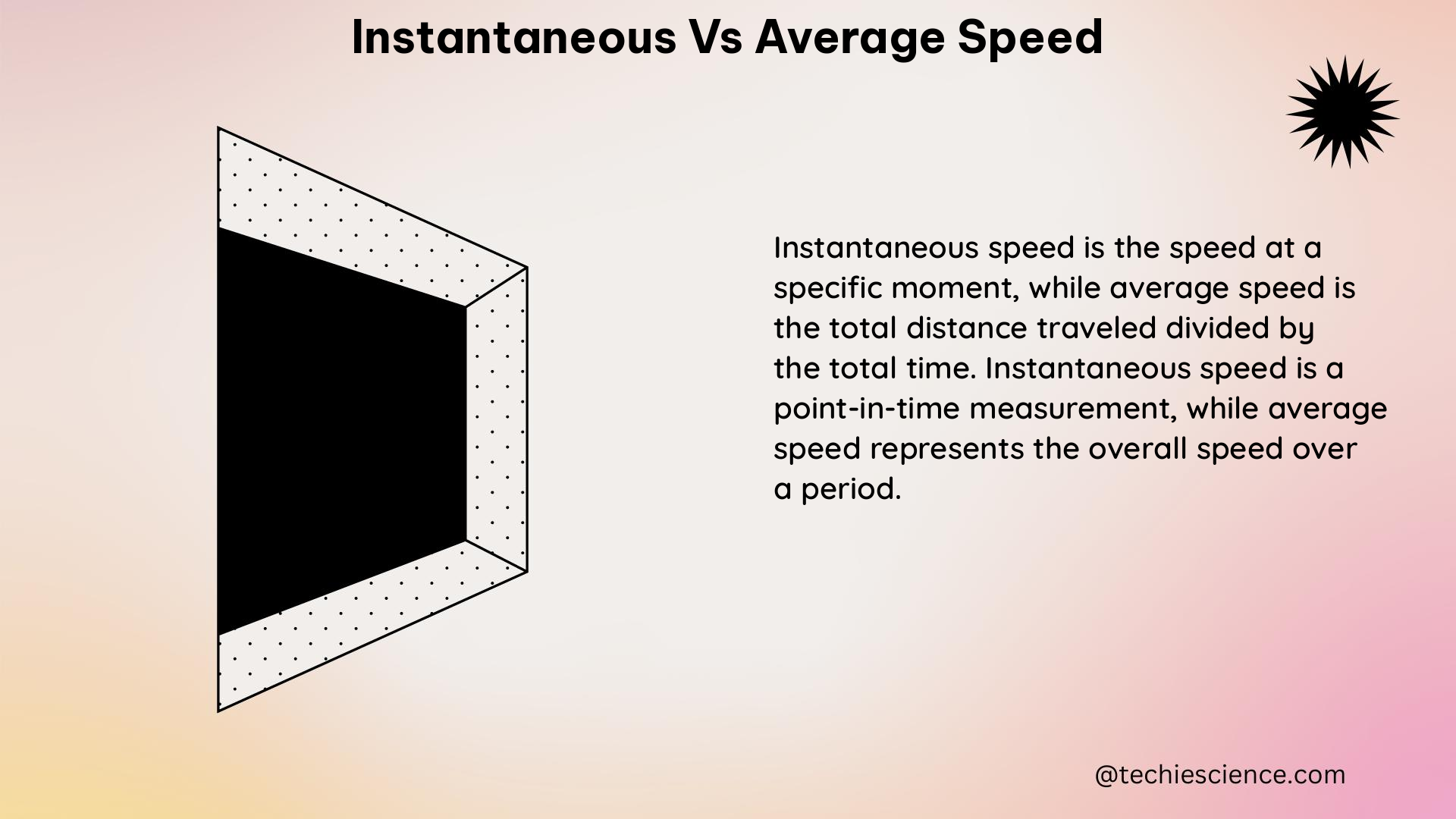Instantaneous speed and average speed are two fundamental concepts in physics that describe the motion of objects. These two measures of speed provide different insights into the movement of an object, and understanding the distinction between them is crucial for physics students. In this comprehensive guide, we will delve into the details of instantaneous and average speed, exploring their definitions, formulas, examples, and real-world applications.
Instantaneous Speed
Definition
Instantaneous speed is the speed of an object at a particular moment in time. It is the limit of the average speed as the time interval approaches zero. Instantaneous speed represents the object’s speed at a specific instant, capturing the rate of change of its position with respect to time.
Formula
The formula for instantaneous speed is:
$\frac{ds}{dt}$
Where:
– $s$ represents the distance traveled by the object
– $t$ represents the time
This formula indicates that instantaneous speed is the derivative of the distance with respect to time, which gives the rate of change of the object’s position at a specific instant.
Examples
- Constant Motion: If an object moves with a constant speed of 10 m/s, its instantaneous speed at any given moment will be 10 m/s.
- Accelerating Motion: Consider an object that moves according to the equation $s(t) = 2t^2 + 3t$. To find the instantaneous speed at a specific time, $t$, we take the derivative of the distance function:
$\frac{ds}{dt} = 4t + 3$
For example, at $t = 2$ seconds, the instantaneous speed is $4(2) + 3 = 11$ m/s.
Numerical Problems
- Instantaneous Speed Calculation:
- Given: $s(t) = 3t^2 + 2t$
- Find the instantaneous speed at $t = 2$ seconds.
- Solution: $\frac{ds}{dt} = 6t + 2$
- Substituting $t = 2$, we get $\frac{ds}{dt} = 6(2) + 2 = 14$ m/s.
Average Speed

Definition
Average speed is the total distance traveled by an object divided by the total time taken. It gives a single value that represents the overall pace of motion, providing a measure of the object’s performance over a given period.
Formula
The formula for average speed is:
$v_{avg} = \frac{d}{t}$
Where:
– $d$ represents the total distance traveled by the object
– $t$ represents the total time taken
Examples
- Constant Motion: If an object travels a distance of 50 meters in 10 seconds, its average speed is $v_{avg} = \frac{50}{10} = 5$ m/s.
- Variable Motion: Consider an object that travels 10 meters in the first 2 seconds and an additional 20 meters in the next 3 seconds. The total distance traveled is 30 meters, and the total time taken is 5 seconds. The average speed is $v_{avg} = \frac{30}{5} = 6$ m/s.
Numerical Problems
- Average Speed Calculation:
- Given: An object travels a distance of 80 kilometers in 2 hours.
- Find the average speed of the object.
- Solution: $v_{avg} = \frac{80}{2} = 40$ km/h.
Key Differences
Instantaneous Speed
- Refers to the speed at a specific instant in time
- Can vary from moment to moment
- Calculated as the derivative of distance with respect to time
Average Speed
- Refers to the total distance traveled divided by the total time taken
- Gives a single value representing the overall pace of motion
- Calculated as the total distance divided by the total time
Real-World Examples
Car Trip
During a trip to school, a car’s instantaneous speed can vary as it accelerates, decelerates, or remains constant. The average speed, however, would be the total distance traveled (e.g., 5 miles) divided by the total time taken (e.g., 0.2 hours), which is 25 miles per hour.
Hiking
If a hiker travels a total distance of 5 kilometers in 2 hours, their average speed is 2.5 kilometers per hour. However, their instantaneous speed at any given moment might be different, depending on the terrain and their pace.
Theoretical Explanation
Mathematical Representation
- Instantaneous speed is represented by the derivative of distance with respect to time, $\frac{ds}{dt}$.
- Average speed is represented by the ratio of total distance to total time, $\frac{d}{t}$.
Physical Interpretation
Instantaneous speed reflects the speed at a specific moment, while average speed provides an overall measure of the pace of motion over a given period.
Figures and Data Points
Distance-Time Graph
A graph showing the distance traveled by an object over time can be used to visualize both instantaneous and average speed. The slope of the tangent line at a specific point represents the instantaneous speed, while the overall slope of the line represents the average speed.
Speedometer Readings
A car’s speedometer readings at regular intervals can be used to calculate both instantaneous and average speed. The instantaneous speed is the reading at a specific moment, while the average speed is the total distance traveled divided by the total time.
Measurements and Values
Units
Instantaneous and average speed are typically measured in units of distance per unit time, such as meters per second (m/s) or kilometers per hour (km/h).
Conversion
To convert between different units, multiplication or division by conversion factors can be used. For example, to convert from meters per second to kilometers per hour, multiply by 3.6.
Theorems and Formulas
- Instantaneous Speed Formula: $\frac{ds}{dt}$
- Average Speed Formula: $v_{avg} = \frac{d}{t}$
- Conversion Formula: $1\text{ m/s} = 3.6\text{ km/h}$
Reference Links
- https://quizlet.com/279143386/chapter-11-review-flash-cards/
- https://www.physicsclassroom.com/mmedia/kinema/trip.cfm
- https://www.ck12.org/flexi/physics/average-velocity/what-is-instantaneous-speed-and-how-is-it-different-from-average-speed/

The lambdageeks.com Core SME Team is a group of experienced subject matter experts from diverse scientific and technical fields including Physics, Chemistry, Technology,Electronics & Electrical Engineering, Automotive, Mechanical Engineering. Our team collaborates to create high-quality, well-researched articles on a wide range of science and technology topics for the lambdageeks.com website.
All Our Senior SME are having more than 7 Years of experience in the respective fields . They are either Working Industry Professionals or assocaited With different Universities. Refer Our Authors Page to get to know About our Core SMEs.